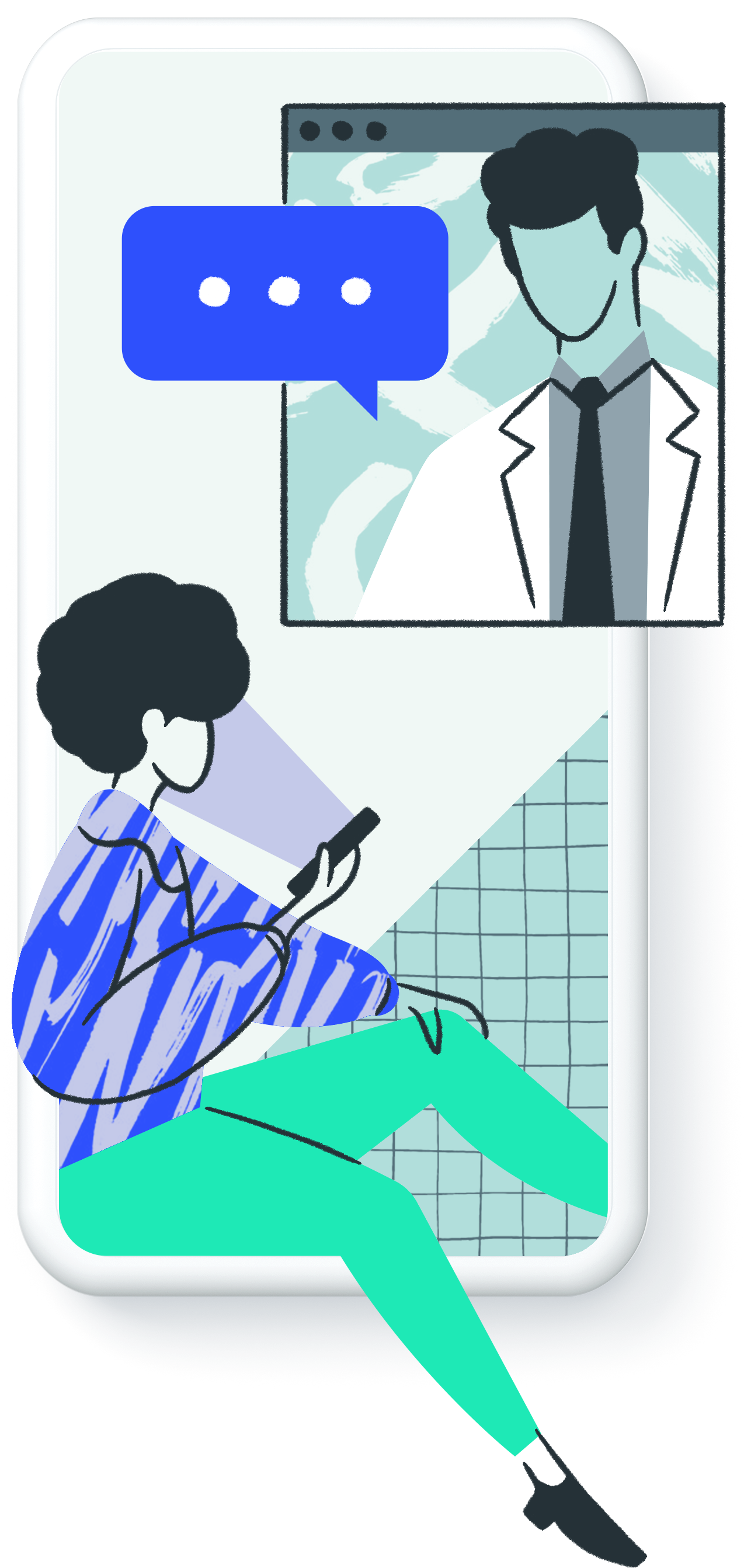- Home
- What we treat
- Joint pains and aches
Coronavirus (COVID-19)
If you are worried about Coronavirus COVID-19 you can check your symptoms on NHS 111. If you need to speak to a doctor over video about any other symptoms you can book an appointment below.
Joint Pain & Aches: An Overview
Everything you need to know about joint pains and aches, including causes, common symptoms and treatment.
What is joint pain?
Joint pain commonly refers to aches, soreness and discomfort in any of the body's joints – common examples being pain or aches in the knees, shoulders, hips or elbows.
Joint pain is prevalent in the UK population, and typically doesn't require hospitalisation or invasive treatment to address.
When should you see a doctor about joint pain?
Joint pain isn't something you need to put a brave face on. See a doctor the moment it strikes and let their advice guide you to a pain-free future. This is especially the case in the following cases:
- When you don't know what caused your joint pain
- When you are experiencing unexplained symptoms alongside joint pain
- When the area around the joint is swollen, tender or warm to the touch
- When the pain has persisted for more than a couple of days
Seek emergency care in the following cases:
- When you have experienced a serious injury
- When you are in severe pain
- When the joint is malformed or misshapen
- When the joint cannot be moved
- When the pain is accompanied by joint swelling or redness, in the presence of a fever
How common is joint pain?
According to Arthritis Research UK, three in ten people had musculoskeletal conditions in 2017 – and as such, 18.8 million people experienced joint pain in a single year. Over half of 65-85+ year olds have musculoskeletal conditions, while less than a third of 35-44 year olds and less than a quarter of 20-34 year olds have them. Only 2.6% of people younger than 20 have musculoskeletal conditions.
There is a slight gender difference in the prevalence of joint pain, though it is not entirely clear why. Arthritis Research found 27.1% of men and 32.5% of women reported musculoskeletal conditions. Further, joint pain is more common in lowest income groups (43%) than it is in groups with the highest income (27%).
What causes joint pain?
There are three main factors that affect musculoskeletal health before we consider any kinds of condition with joint pain as one of their symptoms:
- Physical inactivity. Inactive people put themselves at a significantly greater risk of developing musculoskeletal conditions. Further, even people already suffering with joint pain find respite and relief through exercise. To put this claim into perspective, 45% of people on average with joint pain and musculoskeletal conditions report being inactive, compared to 20% of people in the wider population.
- Obesity. Being overweight or obese, as you might expect, damages weight-bearing joints like knees and hips due to the unusually high loads they are required to carry in obese people. Seven in ten people with joint pain and long-term musculoskeletal conditions are overweight or obese, though admittedly, 58% of the general population are overweight or obese, so this discrepancy is not huge. Once the pain has developed, this can lead to further reductions in activity, increasing the likelihood of obesity being maintained.
- Multimorbidity. Less of a cause and more of an observable pattern. When multimorbidity is present, and so when people are living with two or more long-term health conditions – as one in four people are – musculoskeletal conditions are particularly common. One in eight people living with at least two long-term conditions report one of those conditions to be musculoskeletal.
Other than injury, infection or the overuse of a joint, arthritis is one of the most common causes of joint pain, arguably the cause of joint pain in "most cases" when it comes to pain inside multiple joints simultaneously.
Typical causes of acute arthritis include viral infection, joint disorder (be it an all new condition, or aggravating an existing condition) or gout.
Typical causes of chronic arthritis include inflammatory disorders, osteoarthritis and, in children, juvenile idiopathic arthritis.
Common disorders causing pain around the joints, but outside of them, include fibromyalgia, polymyalgia rheumatica and tendinitis.
What forms of joint pain are there?
Some of the most common types of joint pain found in the UK today.
There are no results for your search. Check your spelling or use fewer words or characters.
Arthritis
Causes pain and inflammation in the joints. More common as you get older, but can affect anyone.
Back pain
A common complaint in people of all ages, either as a result of injury or day-to-day wear and tear.
Gout
A type of arthritis that causes sudden and very severe pain, swelling and inflammation, usually in just one joint.
Hip pain
Symptoms vary greatly depending on the cause, be it general wear and tear, injury or an underlying condition.
Knee pain
The knee bears most of the full weight of your body, and so is naturally the most vulnerable to damage.
Rib cage pain
Rib cage pain can vary in sensation and location, due to several possible causes of the pain.
Shoulder pain
One of the body's most mobile joints, making for a particularly debilitating form of joint pain.
Wrist pain
Whether from injury, long term conditions or RSI, wrist pain is a source of pain that can be easily addressed.
Prolapsed disc
Occurs when one of the discs of cartilage between spinal vertebrae is damaged.
Fibromyalgia
Generally more common in women, fibromyalgia causes constant pain and discomfort.
Sports injuries
Long term or short term, sports injuries are often worth speaking to a GP about to effectively treat and manage.
Musculoskeletal disorders
Particularly painful conditions affecting the muscles, joints, tendons and surrounding tissue.
Your joint pain questions, answered

How is joint pain diagnosed?
First, the doctor will ask questions about your symptoms and medical history, as well as about how long you have experienced your joint pain for. If necessary, they will carry out a physical examination, asking you to position your device to show the joint in question on a video consultation, or moving and manipulating the joint in a traditional consultation.
Expect to answer questions about the severity of the joint pain you experience, what makes the pain worse, and how your symptoms have varied (if at all) over time.
How is joint pain treated?
Treatment for joint pain depends entirely on the underlying cause. That said, there are a few themes in joint pain treatment approaches, no matter what the cause. Inflammation, for instance, can be relieved with the use of nonsteroidal anti-inflammatory drugs, or alternatively with steroid injections into the inflamed joint. Pain not resulting from inflammation, on the other hand, is treated with paracetamol and other painkillers.
In some cases, doctors might need to obtain a fluid sample from the joint area to determine whether or not infection or gout is present. In more extreme cases, doctors may recommend replacing the joint entirely with surgery.
No matter what, applying heat (but not extreme heat – use a heating pad to avoid scalding the skin) may decrease joint pain by relieving spasms in the muscles surrounding the join. Applying cold (but once again, not extreme cold – ice should be wrapped with cloth or plastic) may decrease joint pain by relieving inflammation.
Further, podiatrists can provide invaluable assistance with lower limb or foot pain, occupational therapists can help with adaptations at home or work to make the effects of your pain less impactful, and there is evidence to suggest that acupuncture and other complimentary therapies can be helpful too.
What is the outlook like with joint pain?
With an accurate diagnosis determining the exact cause of your joint pain, as well as what exacerbates and relieves it, your joint pain should at the very least be easier to manage.
Remember to speak to a doctor if you are experiencing joint pain without an obvious cause – especially if your symptoms are present for more than a few days. Scroll to the top of the page to read about specific signs and symptoms to look out for, making sure you catch joint pain early on and give yourself the best possible chance of avoiding the inhibition of your day-to-day movements.

 CQC regulated
CQC regulated
Push Doctor is regulated by the Care Quality Commission (CQC), the independent regulator of health and social care in England.
They are the foremost authority in our industry, assessing health providers' ability to provide people with safe, effective, compassionate and high-quality care – be they offline or online doctors.
Push Doctor is registered with the CQC under the name 'Square Health', with the registration number 1-3060117803.
Our most recent inspection took place in May 2019, concluding that the service we provide is safe, effective, caring, responsive and well-led – gaining a 'Good' rating overall. You can read the report in full on our CQC profile.
 Secure data
Secure data
Push Doctor uses the latest technologies to ensure utmost security. We utilise several layers of firewall security and encrypt all personal data to ensure it’s safe.
All users are required to go through a two-step verification process to create and restore an account. Online access to an account is protected with a password that a user creates and PD apps support touch ID technology.
When using the platform, all personal data is transmitted through the internet using secure socket Layers (SSL) technology. SSL technology causes a browser to encrypt entered information before transmitting it to our secure server. SSL technology, an industry standard, is designed to prevent a third party from capturing and viewing Personal Data.
 Authorised medicines seller
Authorised medicines seller
Push Doctor is registered with the Medicines & Healthcare products Regulatory Agency (MHRA), and fully approved to sell medicines from our website.
We have been approved sellers since our inception, with the company number of C46132. As authorised MHRA sellers, we are approved to sell the following as and when we need to do so:
- Prescription only medicines
- General sales list medicines
- Pharmacy medicines
We regularly review the medications that we prescribe on our service, making sure to meet best practice and only ever provide outstanding care. With this, and our CQC rating, you know you are in safe hands.
 GMC-registered GPs
GMC-registered GPs
All of our doctors are NHS-trained and registered with the General Medical Council (GMC), ensuring that you are only ever receiving the best possible care and advice.
We encourage you to familiarise yourself with our online doctors, check their GMC profiles for yourself – every doctor on our platform has one, which you can easily search the GMC's database for.
In the majority of cases, we even give a direct link to our doctors' LinkedIn pages so you can see where they have worked in the past and where they were educated.
You can also see who our medical support and data protection teams are as well.
We welcome scrutiny, and encourage you to get in touch if you have any questions, concerns or comments about the people that power Push Doctor.
